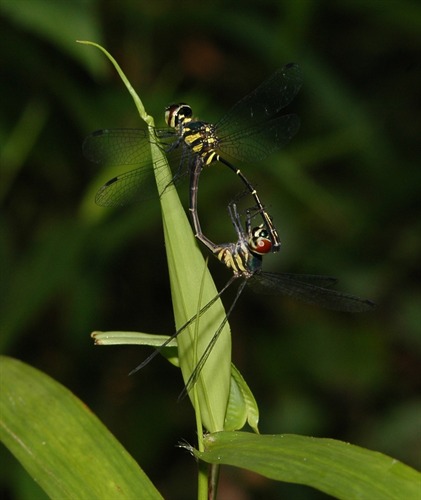
Back
Risiophlebia dohrni (Krüger, 1902)
| Family Name: | Libellulidae |
| Taxonomic Group: | Invertebrates (Dragonfly and Damselfly) |
Name
Description
| Description | This species is characterised by the greatly swollen abdominal segments 1-3. Male and female are similar, but the base of the abdomen is less strongly swollen in the female. The thorax and abdomen are dark metallic with yellow markings. Eyes are reddish brown on the top, pale yellowish white with pale dark areas below. |
|---|
Ecology, Habitat & Location
| Ecological Notes | Associated with pools in densely shaded freshwater swamp forest, in Singapore confined to a single site in Nee Soon. An excessively rare species of which only about three to four specimens were previously known, these from Sumatra and Billiton. The Singapore location is less than a hectare of pristine swamp forest over a mosaic of deeply shaded muddy pools, very difficult to penentrate, in the centre of the Nee Soon forest reserve. Here the adults can be seen hovering in mid-air a foot or so above the water. The larvae are unknown but presumably will be found somewhere in the ponds when we have time to search for them. This could be important because Risiophlebia is believed to be one of the most primitive members of its family and the larval structure may give valuable clues to relationships between the Family Libellulidae and other families in the group. |
|---|---|
| Habitats | Freshwater, Freshwater Swamp Forest |
| Distribution | Sumatra and Billiton Island, and now Pulau Bintan (Riau Archipelago) and Sumatra. |
| Nature Reserves | Central Catchment Nature Reserve |
Conservation
| Trends & Threats | Apart from the obvious risk of site modification, the fact that the Nee Soon swamp forest is in a military area poses an additional threat from possible chemical contamination. |
|---|---|
| Scientific Interest & Potential Value | The Odonata comprises the well-known dragonflies and damselflies many of which are common and conspicuous near water-bodies of all types. An unpublished list of Singapore species (D.H. Murphy) records 89 species, many of which are extremely rare and two at least are probably undescribed. However, some of the species recorded even less often than Risiophlebia are likely to be migrants, not necessarily breeding continuously in Singapore, and it is those species confined to our few areas of pristine forest that most urgently need conservation. Several great rarities exist in the Bukit Timah reserve but this is a larger area and perhaps less at risk from exploitation. Rarity alone might not be the only criterion anyway. The damselfly Coeliccia octagesmia was described from Singapore and occurs, patchily, elsewhere in Southeast Asia. Today it survives in Singapore as a single healthy but extremely localised population in a tiny stream in wasteland alongside Commonwealth Avenue West, unfortunately scheduled for development. |
| Conservation Notes | Habitat protection. |
Status
| Species Status | Native |
|---|---|
| Conservation Status | Very Rare |
| Singapore Red Data Book Status | Critically Endangered (CR) [2008] |
Photos
References
| References | Davison, G.W.H., Ng, P.K.L. & Ho, H.C (Eds.). 2008. The Singapore Red Data Book (2nd Edition). Singapore: Nature Society (Singapore). 285pp Tang, H.B., Wang, L.K. & Hämäläinen, M. 2010. A photographic guide to the dragonflies of Singapore. Singapore: Raffles Museum of Biodiversity Research. 222pp. |
|---|
